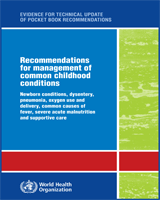All rights reserved. Publications of the World Health Organization are available on the WHO web site (www.who.int) or can be purchased from WHO Press, World Health Organization, 20 Avenue Appia, 1211 Geneva 27, Switzerland (tel.: +41 22 791 3264; fax: +41 22 791 4857; e-mail: tni.ohw@sredrokoob). Requests for permission to reproduce or translate WHO publications – whether for sale or for noncommercial distribution – should be addressed to WHO Press through the WHO web site (http://www.who.int/about/licensing/copyright_form/en/index.html).
NCBI Bookshelf. A service of the National Library of Medicine, National Institutes of Health.
Recommendations for Management of Common Childhood Conditions: Evidence for Technical Update of Pocket Book Recommendations: Newborn Conditions, Dysentery, Pneumonia, Oxygen Use and Delivery, Common Causes of Fever, Severe Acute Malnutrition and Supportive Care. Geneva: World Health Organization; 2012.

Recommendations for Management of Common Childhood Conditions: Evidence for Technical Update of Pocket Book Recommendations: Newborn Conditions, Dysentery, Pneumonia, Oxygen Use and Delivery, Common Causes of Fever, Severe Acute Malnutrition and Supportive Care.
Show details11.1. Sublingual administration of sugar in treatment of hypoglycaemia
Sublingual sugar may be used as an immediate first aid measure in managing hypoglycaemia in children in situations where intravenous administration of glucose may be impossible or delayed.
(Strong recommendation, low quality evidence)
This recommendation places value on ease of use, low cost, and high availability in the absence of any serious risk, although the evidence is of low quality.
11.1.1. Evidence and summary of findings
The panel identified two randomized controlled trials (RCTs) from Burkina Faso and Mali, cited in a recent review of the management of hypoglycaemia [Achoki, 2010].
Barennes et al (2005) conducted an open-label, quazi-randomized trial of intravenous glucose, sublingual sugar, and oral sugar in Burkina Faso. Children aged 6 months to 15 years presenting to the outpatient department were eligible if: 1) they had symptoms and signs of either acute respiratory infection (excluding pneumonia) or malaria; 2) the caregiver agreed to attend an appointment the next morning; and 3) they had a blood glucose level between 3.3 to 5 mmol/l.
The study screened 156 children; 87 were excluded, including 19 children initially assigned to the sublingual group, who swallowed the sugar within the first 10 minutes. Sixty-nine were randomized to one of five groups: 1) half a tablespoon of water (n = 11); 2) IV glucose (8 mL of 30% dextrose administered in a single bolus); 3) oral glucose (2.5 g sugar); 4) single dose sublingual group (2.5 g of wet sugar under the tongue); or 5) double dose sublingual group. The main outcome was treatment failure: the proportion of children who did not reach blood glucose >5.6 during the study period.
Baseline characteristics were similar across groups. There were no treatment failures in the sublingual or intravenous groups, compared with 8 (53%) and 9 (81.8%) in the oral and water groups respectively (p < 0.05). The approximate bioavailability was 84% for sublingual administration. The mean (SD) time to reach a blood glucose > 5.6 was 28.5 (10.6) minutes and 25.7 (9.5) for the sublingual and intravenous groups, respectively.
Graz et al (2008) was an open-RCT of intravenous versus sublingual sugar in children with severe malaria and hypoglycaemia in Mali. Children were eligible if they had: 1) WHO-defined severe malaria; 2) seizures, or an altered/impaired state of consciousness; and 3) hypoglycaemia (blood gluocose < 3.3 mmol/L).
Twenty-six children were randomly allocated to receive sublingual sugar (a teaspoon [2.5–3.5 g] of moistened sugar; n = 14) or intravenous sugar (5 ml/kg 10% glucose; n = 12). Sublingual administration was repeated every 20 minutes for 2 hours. Primary outcome was treatment response rate: reaching a blood glucose > 3.3 mmol/L during the first 40 minutes. Secondary outcomes included relapse rate and treatment delay.
The only difference in baseline characteristics was a trend towards more children with coma in the intravenous group (p = 0.06). There was no significant difference in the treatment response rate (71% in sublingual and 67% in intravenous, p = 0.81). However, there was a trend towards more relapses in the sublingual group (30% versus 17%, p=0.55). Treatment delay was longer for the intravenous group (18.9 minutes versus 5 minutes), and due to this, the increase in blood glucose from time of diagnosis of hypoglycaemia was faster in the sublingual group.
Complications: two children in the sublingual group swallowed the sugar, and failed to reach normo-glycaemia by 40 minutes. According to study protocol, they were switched to intravenous delivery. In the intravenous group, the infusion was blocked in one child.
11.1.2. Benefits and risks
Benefits
Sublingual sugar appears to be well-tolerated, safe, and efficacious. It is easy to administer, rapidly increases blood glucose levels, and is better than no treatment in situations where IV glucose infusion may be delayed or not available. It can be administered by unskilled health-care workers or parents as a first-aid measure in many rural health centres.
Risks
Possibility of treatment failures because of clenched teeth and swallowing of the sugar. It has 30% hypoglycaemia relapse and could give false confidence in situations where blood glucose levels may not be monitored.
11.1.3. Acceptability and feasibility
Sublingual sugar is child-friendly, easy to administer, and does not require skilled health workers. Children will not be distressed due to inserting an IV line and would be a more acceptable treatment than IV infusions. Active participation by parents in the care of their children may also increase. As sugar is readily available in most places, it may be immediately administered in most circumstances and does not require a prescription or other additional materials for use. It is easy to implement widely in all settings, including peripheral health centres and in the communities where intravenous glucose is not available.
- Evidence for Recommendations for Treatment of Hypoglycaemia - Recommendations fo...Evidence for Recommendations for Treatment of Hypoglycaemia - Recommendations for Management of Common Childhood Conditions
Your browsing activity is empty.
Activity recording is turned off.
See more...